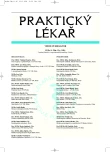New approaches to heart valve diseases in experimental and clinical cardiology
Nové přístupy k chlopenním vadám srdce v experimentální a klinické kardiologii
V současné době vzrůstá snaha ovlivňovat chlopenní vady katetrizační cestou:
je zřetelný nárůst různých technik v experimentu na zvířeti, ale je rovněž evidentní, že některé metody již pronikly i do klinického použití. V tomto sdělení je proveden přehled o různých možnostech řešení daného problému a rovněž i některá morfologická pozorování. Zatím je příliš brzy na to, aby se mohly zhodnotit různé metody zamýšlené jako trvalé řešení různých chlopenních vad srdce. Je to dáno tím, že zatím je realizováno relativně málo výkonů a především tím, že není známá trvanlivost provedených výkonů. Navíc úroveň dnešní kardiochirurgie je velmi vysoká. V protikladu tomu všek lze poměrně snadno akceptovat myšlenku na dočasné katetrizační řešení vad, které jsou v daném okamžiku neschůdné k chirurgickému řešení, nebo kde je případná operace spojena s neúměrně vysokým rizikem.
Klíčová slova:
experimentální metody, chlopenní vady srdce, nechirurgické přístupy
Authors:
J. Šochman 1; J. H. Peregrin 2
Authors‘ workplace:
Klinika kardiologie IKEM Přednosta: prof. MUDr. J. Kautzner, CSc.
1; Základna radiodiagnostiky a intervenční radiologie Přednosta: doc. MUDr. J. H. Peregrin, CSc.
Institut klinické a experimentální medicíny, Praha Ředitel: MUDr. Štefan Vítko, CSc.
2
Published in:
Prakt. Lék. 2006; 86(11): 635-642
Category:
Of different specialties
Overview
There has been a clear increase in the number of techniques in animal experiments dealing with various approaches to nonsurgical modification of heart valve diseases. It is also evident that some of the methods have already been put to use in clinical practice. This paper presents an overview of various options of the handling this issue and provides some morphological observations. It seems it is still too early to evaluate the different methods intended for a permanent solution to various cardiac valve defects. This is because relatively few procedures have been performed to date and, more importantly, nothing is known about the durability of the procedures. In addition, the standard of current cardiac surgery is very high. Still, it is quite easy to accept the idea for temporary catheter-based treatment of types of diseases currently not eligible for surgery, or in cases where surgery would be associated with unacceptably high risk.
Key words:
experimental methods, heart valve diseases, nonsurgical techniques
Labels
General practitioner for children and adolescents General practitioner for adultsArticle was published in
General Practitioner

2006 Issue 11
- Metamizole at a Glance and in Practice – Effective Non-Opioid Analgesic for All Ages
- Memantine in Dementia Therapy – Current Findings and Possible Future Applications
- Advances in the Treatment of Myasthenia Gravis on the Horizon
- Possibilities of Using Metamizole in the Treatment of Acute Primary Headaches
- Hope Awakens with Early Diagnosis of Parkinson's Disease Based on Skin Odor
Most read in this issue
- Experience in the treatment of torpid condylomata acuminata by 5% imiquimod cream
- Anaemia in chronic heart failure
- Indications of allogeneic and autologous haematopoietic cells transplantation – Recommendations of the Czech Society of Haematology and Czech Society of Oncology of the J. E. Purkyně Czech Medical Association.
- Valganciclovir in the pre-emptive treatment of cytomegalovirus infections following allogeneic stem cell transplantation.
